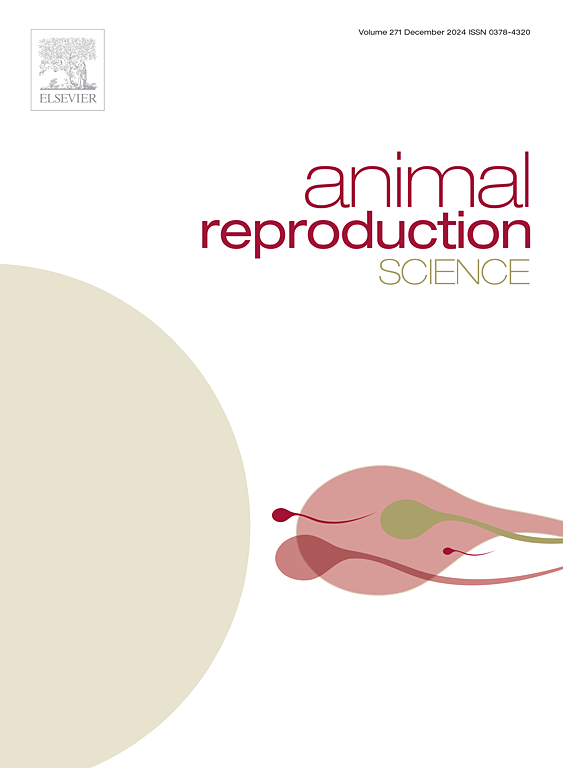基于新型激素制剂的定时人工授精新技术对后备母猪的影响
IF 3.3
2区 农林科学
Q1 AGRICULTURE, DAIRY & ANIMAL SCIENCE
引用次数: 0
摘要
本研究评估了一种新的固定时间人工授精(FTAI)方案对后备母猪的影响,该方案结合了阿替诺素片(ALT-T)、长效重组猪卵泡激素(rpFSH)和重组人绒毛膜促性腺激素(rhCG)。将160头后备母猪分为对照组(n = 80)和新处理组(n = 80)。对照母猪口服阿替诺酯溶液(20 mg/天)18天,治疗42 h后给予1000 IU马绒毛膜促性腺激素(eCG), 80 h后给予100 μg GnRH。新治疗组在等效时间点给予ALT-T、40 μg rpFSH + 200 IU rhCG、400 IU rhCG治疗。两组分别在GnRH/rhCG给药后24 h和40 h进行了两次人工授精。除了ALT-T治疗期间LH水平升高(P <; 0.05)外,激素谱(ALT-T、FSH、E2、P4)各组间无显著差异。两种给药方式的卵泡大小相当,但在对照组12 h排卵前卵泡大小明显变大(6.99 vs. 6.57 mm, P <; 0.05)。两组的生殖结局包括发情率(76.25 % vs. 76.25 %)、妊娠率(88.52 % vs. 91.80 %)和分娩率(94.44 % vs. 94.64 %),差异均无统计学意义。值得注意的是,新处理组产仔率更高,产仔总数(13.81比11.80,P <; 0.05)和活产仔猪(11.81比10.39,P <; 0.05)显著增加。这些发现表明,与传统方案相比,新的FTAI方案在提高产仔率的同时实现了相当的同步效果,支持其作为后备母猪生殖管理的有效替代方案。本文章由计算机程序翻译,如有差异,请以英文原文为准。
Effect of the new fixed-time artificial insemination technology based on novel hormone preparations in gilts
This study evaluated the effect of a novel fixed-time artificial insemination (FTAI) protocol for gilts, which incorporates altrenogest tablets (ALT-T), long-acting recombinant porcine FSH (rpFSH), and recombinant hCG (rhCG). A total of 160 gilts were divided into the control (n = 80) and the new treatment (n = 80) groups. Control gilts received oral altrenogest solution (20 mg/day) for 18 days, followed by 1000 IU equine chorionic gonadotropin (eCG) administered 42 h post-treatment and 100 μg GnRH 80 h later. The new treatment group received ALT-T, 40 μg rpFSH + 200 IU rhCG, and 400 IU rhCG at equivalent time points. Both groups underwent dual inseminations at 24 h and 40 h after GnRH/rhCG administration. Hormonal profiles (altrenogest, FSH, E2, P4) showed no significant differences between the groups, except for a higher LH level (P < 0.05) during ALT-T treatment. Follicle sizes were comparable during the two types of altrenogest administration but became significantly larger in the control group 12 h pre-ovulation (6.99 vs. 6.57 mm, P < 0.05). There was no significant difference in reproductive outcomes between two groups including estrus rate (76.25 % vs. 76.25 %), pregnancy rate (88.52 % vs. 91.80 %) and farrowing rate (94.44 % vs. 94.64 %). Notably, the new treatment group exhibited superior litter productivity with significantly increased total born (13.81 vs. 11.80, P < 0.05) and live-born piglets (11.81 vs. 10.39, P < 0.05). These findings suggest that the new FTAI protocol achieves comparable synchronization efficacy while enhancing litter productivity compared to traditional regimens, supporting its use as an effective alternative for gilts reproductive management.
求助全文
通过发布文献求助,成功后即可免费获取论文全文。
去求助
来源期刊

Animal Reproduction Science
农林科学-奶制品与动物科学
CiteScore
4.50
自引率
9.10%
发文量
136
审稿时长
54 days
期刊介绍:
Animal Reproduction Science publishes results from studies relating to reproduction and fertility in animals. This includes both fundamental research and applied studies, including management practices that increase our understanding of the biology and manipulation of reproduction. Manuscripts should go into depth in the mechanisms involved in the research reported, rather than a give a mere description of findings. The focus is on animals that are useful to humans including food- and fibre-producing; companion/recreational; captive; and endangered species including zoo animals, but excluding laboratory animals unless the results of the study provide new information that impacts the basic understanding of the biology or manipulation of reproduction.
The journal''s scope includes the study of reproductive physiology and endocrinology, reproductive cycles, natural and artificial control of reproduction, preservation and use of gametes and embryos, pregnancy and parturition, infertility and sterility, diagnostic and therapeutic techniques.
The Editorial Board of Animal Reproduction Science has decided not to publish papers in which there is an exclusive examination of the in vitro development of oocytes and embryos; however, there will be consideration of papers that include in vitro studies where the source of the oocytes and/or development of the embryos beyond the blastocyst stage is part of the experimental design.
 求助内容:
求助内容: 应助结果提醒方式:
应助结果提醒方式:


